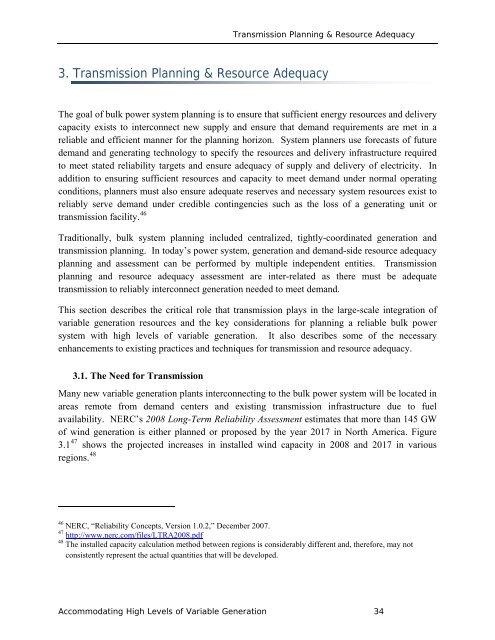Accommodating High Levels of Variable Generation - NERC
Accommodating High Levels of Variable Generation - NERC
Accommodating High Levels of Variable Generation - NERC
Create successful ePaper yourself
Turn your PDF publications into a flip-book with our unique Google optimized e-Paper software.
Transmission Planning & Resource Adequacy<br />
3. Transmission Planning & Resource Adequacy<br />
The goal <strong>of</strong> bulk power system planning is to ensure that sufficient energy resources and delivery<br />
capacity exists to interconnect new supply and ensure that demand requirements are met in a<br />
reliable and efficient manner for the planning horizon. System planners use forecasts <strong>of</strong> future<br />
demand and generating technology to specify the resources and delivery infrastructure required<br />
to meet stated reliability targets and ensure adequacy <strong>of</strong> supply and delivery <strong>of</strong> electricity. In<br />
addition to ensuring sufficient resources and capacity to meet demand under normal operating<br />
conditions, planners must also ensure adequate reserves and necessary system resources exist to<br />
reliably serve demand under credible contingencies such as the loss <strong>of</strong> a generating unit or<br />
transmission facility. 46<br />
Traditionally, bulk system planning included centralized, tightly-coordinated generation and<br />
transmission planning. In today’s power system, generation and demand-side resource adequacy<br />
planning and assessment can be performed by multiple independent entities. Transmission<br />
planning and resource adequacy assessment are inter-related as there must be adequate<br />
transmission to reliably interconnect generation needed to meet demand.<br />
This section describes the critical role that transmission plays in the large-scale integration <strong>of</strong><br />
variable generation resources and the key considerations for planning a reliable bulk power<br />
system with high levels <strong>of</strong> variable generation. It also describes some <strong>of</strong> the necessary<br />
enhancements to existing practices and techniques for transmission and resource adequacy.<br />
3.1. The Need for Transmission<br />
Many new variable generation plants interconnecting to the bulk power system will be located in<br />
areas remote from demand centers and existing transmission infrastructure due to fuel<br />
availability. <strong>NERC</strong>’s 2008 Long-Term Reliability Assessment estimates that more than 145 GW<br />
<strong>of</strong> wind generation is either planned or proposed by the year 2017 in North America. Figure<br />
3.1 47 shows the projected increases in installed wind capacity in 2008 and 2017 in various<br />
regions. 48<br />
46 <strong>NERC</strong>, “Reliability Concepts, Version 1.0.2,” December 2007.<br />
47 http://www.nerc.com/files/LTRA2008.pdf<br />
48 The installed capacity calculation method between regions is considerably different and, therefore, may not<br />
consistently represent the actual quantities that will be developed.<br />
<strong>Accommodating</strong> <strong>High</strong> <strong>Levels</strong> <strong>of</strong> <strong>Variable</strong> <strong>Generation</strong> 34
















